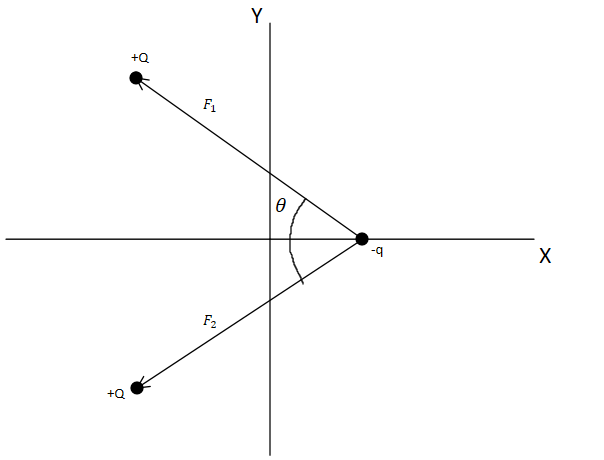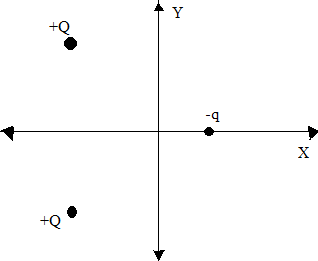
Answer
91.5k+ views
Hint: Unlike charges exert an attractive electrostatic force on each other. The charge will move in the direction of the net force acting on it. Balancing the forces on the charge will give us the value of the net force and its direction.
Complete step by step answer:

From the above figure we get to know that ${F_1}$ and ${F_2}$ are the two forces which are acting on the negative charge $ - q$ because of the positive charges $ + Q$. The force acting here is of electrostatic nature. So, electrostatic force can be calculated by the Coulomb’s Law, that is,
$F = \dfrac{{k{q_1}{q_2}}}{{{r^2}}}$
Where, $F = $electrostatic force
${q_1},{q_2} = $ Magnitudes of the charges
$r = $ Distance between the two charges.
$k = $ Proportionality constant $ = 9 \times {10^9}N{m^2}/{C^2}$
In this case,
$\Rightarrow {F_1} = \dfrac{{kQq}}{{{r^2}}}$
$\Rightarrow {F_2} = \dfrac{{kQq}}{{{r^2}}}$
$\Rightarrow {F_1} = {F_2} = F$
The formula for net force when both the forces are equal is,
$\Rightarrow {F_{net}} = 2F\cos \dfrac{\theta }{2}$
Now because of this force the negatively charged particle will start moving along the direction of decreasing $X$ values until the value of $\theta = {180^o}$ because at that point,
$\Rightarrow {F_{net}} = 2F\cos \dfrac{{180}}{2}$
$\Rightarrow {F_{net}} = 2F\cos 90$
$\Rightarrow {F_{net}} = 0$ because $\cos 90^\circ = 0$.
So at this point no net force is acting on the negatively charged particle. But it has attained velocity, because of which it will not stop moving. As soon as the particle starts moving a constantly varying net force again starts acting on it, which varies with the varying values of $\theta $ and will move until a position at which its velocity becomes zero and net force attains its maximum value. At that point the particle comes to rest momentarily and again starts moving but now in the opposite direction as compared to previous time. And this motion will go on continuously until any external force is applied on it. And this kind of motion is known as Oscillatory motion.
Hence option D is the correct answer.
Note: The position at which no net force is acting on the particle is known as mean position. The maximum displacement the particle can take from the mean position is known as its Amplitude. When the particle starts from the mean position goes towards the positive extreme, returns to the mean position goes to the negative extreme and again comes back to the mean position, this complete cycle is known as one oscillation.
Complete step by step answer:

From the above figure we get to know that ${F_1}$ and ${F_2}$ are the two forces which are acting on the negative charge $ - q$ because of the positive charges $ + Q$. The force acting here is of electrostatic nature. So, electrostatic force can be calculated by the Coulomb’s Law, that is,
$F = \dfrac{{k{q_1}{q_2}}}{{{r^2}}}$
Where, $F = $electrostatic force
${q_1},{q_2} = $ Magnitudes of the charges
$r = $ Distance between the two charges.
$k = $ Proportionality constant $ = 9 \times {10^9}N{m^2}/{C^2}$
In this case,
$\Rightarrow {F_1} = \dfrac{{kQq}}{{{r^2}}}$
$\Rightarrow {F_2} = \dfrac{{kQq}}{{{r^2}}}$
$\Rightarrow {F_1} = {F_2} = F$
The formula for net force when both the forces are equal is,
$\Rightarrow {F_{net}} = 2F\cos \dfrac{\theta }{2}$
Now because of this force the negatively charged particle will start moving along the direction of decreasing $X$ values until the value of $\theta = {180^o}$ because at that point,
$\Rightarrow {F_{net}} = 2F\cos \dfrac{{180}}{2}$
$\Rightarrow {F_{net}} = 2F\cos 90$
$\Rightarrow {F_{net}} = 0$ because $\cos 90^\circ = 0$.
So at this point no net force is acting on the negatively charged particle. But it has attained velocity, because of which it will not stop moving. As soon as the particle starts moving a constantly varying net force again starts acting on it, which varies with the varying values of $\theta $ and will move until a position at which its velocity becomes zero and net force attains its maximum value. At that point the particle comes to rest momentarily and again starts moving but now in the opposite direction as compared to previous time. And this motion will go on continuously until any external force is applied on it. And this kind of motion is known as Oscillatory motion.
Hence option D is the correct answer.
Note: The position at which no net force is acting on the particle is known as mean position. The maximum displacement the particle can take from the mean position is known as its Amplitude. When the particle starts from the mean position goes towards the positive extreme, returns to the mean position goes to the negative extreme and again comes back to the mean position, this complete cycle is known as one oscillation.
Recently Updated Pages
Name the scale on which the destructive energy of an class 11 physics JEE_Main

Write an article on the need and importance of sports class 10 english JEE_Main

Choose the exact meaning of the given idiomphrase The class 9 english JEE_Main

Choose the one which best expresses the meaning of class 9 english JEE_Main

What does a hydrometer consist of A A cylindrical stem class 9 physics JEE_Main

A motorcyclist of mass m is to negotiate a curve of class 9 physics JEE_Main

Other Pages
Electric field due to uniformly charged sphere class 12 physics JEE_Main

If a wire of resistance R is stretched to double of class 12 physics JEE_Main

Derive an expression for maximum speed of a car on class 11 physics JEE_Main

3 mole of gas X and 2 moles of gas Y enters from the class 11 physics JEE_Main

A soldier with a machine gun falling from an airplane class 11 physics JEE_MAIN

Velocity of car at t 0 is u moves with a constant acceleration class 11 physics JEE_Main




